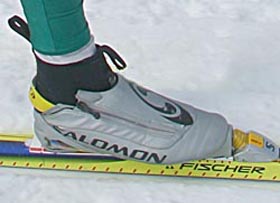Nordic Boots
By
Rob Rinaldi,DPM
Posted December 1st, 2008

Many winter foot injuries happen because of poorly fit, worn-out, deformed ski and snowshoe boots.
Improper boots cause foot problems of Nordic skiers and snowshoers Vermont is about to become a winter wonderland once again, and many of you will be headed out to the trails and woods to enjoy this most spectacular season. By now, you’ve probably taken the skis off the rack for pre-season tuning and dusted off your snowshoes, but have you checked your footgear? Many winter foot injuries happen because of poorly fit, worn-out, deformed ski and snowshoe boots. You would expect the short-shoe-syndrome to happen only to the young, growing foot, but adults can suffer from the problem, too. Boots, even those made from synthetics, can become misshapen or shrink to some degree. Weight gain also affects shoe fit. An adult who has gained 10 pounds over the last year will not only have a change in clothing size, but his or her foot size will have increased, too.
BLOOD FLOW
The short, ill fitted, tight boot can restrict normal blood flow, resulting in thermal discomfort and even frostbite. Frostbite can be very complex and dangerous, especially to people suffering from conditions that result in small vessel disease. A diabetic, as an example, must be careful to prevent thermal injuries. Even with excellent sugar controls, a diabetic will suffer small vessel disease as a normal progression of diabetes. Diabetics should have an annual check for neuropathy as this syndrome may alter the foot’s perception of cold temperatures. Small vessel disease primarily affects feet, and this can reduce an athlete’s ability to withstand cold temperatures without injury. Footgear that is restrictive because of age, shape or size can further impede blood flow into feet.
Snowshoeing and cross-country skiing is popular with the master and grandmaster athletes, but these same people must execute caution when dealing with the frigid temps. Check your ski or hiking boot’s shape and fit before the season starts. Make sure nothing is too small.
NERVE DAMAGE
Short or misshapen shoes can also cause nerve compression syndromes in feet. The telltale sign of nerve compression are toes that become numb and tingling. Several nerves course the top of the foot. They are subject to compression syndrome because they pass through an area of the foot that has very little protective tissue. The nerves can become trapped between bone and the shoe. A shoe that is laced too tightly, that has a twisted tongue, or is too small in circumference because of shrinkage or wear can cause nerve compression syndrome. Nerve damage can be substantial and lasting.
SOFT TISSUE INJURY
Faulty fitting footgear can cause injury to muscles, tendons and ligaments. A common injury is to the attachment of the Achilles tendon to the heel bone. A short shoe can increase forces to this vulnerable area. The Achilles and the shock-absorbing bursa structure behind the large boney prominence of the heel need to fit comfortably into the back of a boot; to have these wedged tight because of a short fit can cause injury to the tendon. The most common sign of an Achilles injury is pain and stiffness in the tendon. Unfortunately, the symptoms don’t happen until after a trek, when the tendon is already injured.
Short boots, or even your favorite old “broken-in” boots, can contribute to plantar fascia injury. Ill-fitted, improper, or worn out shoes in ANY sport commonly cause plantar fascitis, a disability that can prevent you from enjoying normal daily activities.
Worn, poorly fitting boots often cause tendonitis of the posterior tibial tendon, and the peroneal tendon. The shoe’s inability to function properly with the foot under the stresses of the sport is very often a prime contributor of overuse injury to these tendons.
BONE and JOINT INJURY
Cross-country skiing and snowshoeing both stress the first metatarsal-phalangeal joint (big toe), putting it at risk for substantial injury. A poor-fitting boot can increase the stress, especially in the propulsive gait phase of snowshoeing or the kick-off phase of skiing. Slipping, which is common on any snow trek, can add insult to injury.
A boot with a damaged toe box, or one that has shrunk and become misshapen, can cause undue stress and compression on the first metatarsal-phalangeal joint, resulting in both cartilage and bone injury. Cartilage injuries are often not reparable and will leave the joint with lasting dysfunction, progressive arthritis and limitations of motion.
AVOID BAD-BOOT-INJURY
Snowshoeing and cross-country skiing are enjoyable sports and offer a fantastic workout. I truly believe you can stave off cabin fever at least until April with routine treks into the woods and trails on a beautiful, snowy, winter day. Good equipment is the key to enjoying these sports. Take advantage of the latest equipment designs, practice techniques with short treks, engage in preseason muscle adaptation routines and check all your equipment before the season begins. Every year, your winter equipment check should begin with footgear.
